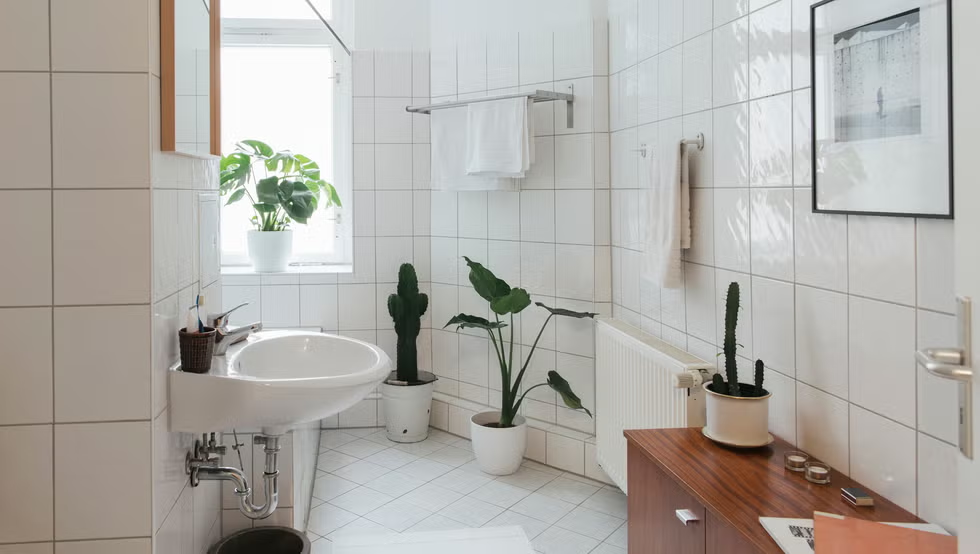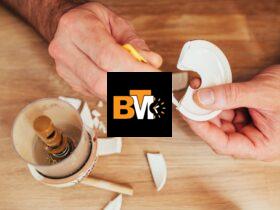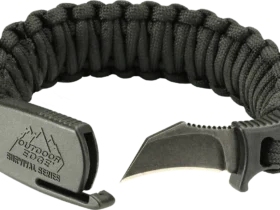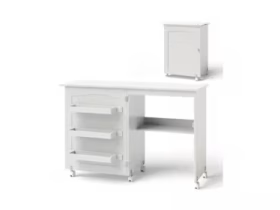Setting Up for Success
To clean your bathroom effectively, make sure you have the right tools and prep each area properly. Doing so can save time and reduce stress when cleaning.
Gathering Your Cleaning Supplies
First, gather all the supplies you’ll need. Essential items include bathroom cleaner, all-purpose cleaner, glass cleaner, and a toilet cleaner. Keep a microfiber cloth on hand for wiping surfaces, as it’s great at trapping dust and grime.
In addition, have a disposable duster for hard-to-reach nooks and crannies. A toilet bowl cleaner and brush are important for scrubbing the toilet. Keep these supplies in a small caddy, so you don’t waste time searching for them. This makes the cleaning process more efficient and enjoyable.
Pre-Cleaning Preparation
Before you begin cleaning, do some simple prep work. Start by removing clutter from countertops. Put away any toiletries and personal items. This ensures that you have easy access to all surfaces.
Next, dust the areas around the toilet, baseboards, and light fixtures using a duster or microfiber cloth. This prevents the creation of a wet sludge when you clean with liquids. Organizing and decluttering the space before you start will make it easier to tackle stubborn spots.
Daily and Weekly Cleaning Habits
Keeping your bathroom clean and fresh involves adopting daily and weekly habits. These practices ensure soap scum doesn’t build up and your toilet remains spotless. You can avoid major cleaning tasks by addressing these areas regularly.
Counteracting Soap Scum and Water Spots
Soap scum and water spots can make your bathroom look dull. To counteract them, consider using a microfiber cloth for daily wipe-downs of your shower doors and tiles. Microfiber is effective at grabbing grime without leaving any lint.
White vinegar is a natural solution for tackling tough soap scum. Spray it on affected areas, let it sit for a bit, then wipe it off with a clean cloth. For water spots, especially on faucets and mirrors, utilizing a mixture of water and vinegar can shine those surfaces up nicely.
It’s also helpful to keep a squeegee in the shower. After each shower, a quick swipe with the squeegee can prevent water marks and soap residue from sticking around.
Toilet Maintenance
Regular toilet maintenance doesn’t have to be difficult. For daily upkeep, keep a container of disinfecting wipes nearby to quickly clean the seat and handle. This simple habit can help stop the spread of germs and keep odors at bay.
Once a week, perform a thorough cleaning. Use a toilet brush and a good cleaner to scrub under the rim and inside the bowl. Let the cleaner sit for a few minutes to break down any buildup before scrubbing. For hard water stains, a sprinkle of baking soda with some vinegar can do wonders.
By integrating these habits into your routine, you keep your bathroom sparkling clean without a lot of extra effort.
Deep Cleaning Techniques
Deep cleaning your bathroom means tackling stubborn spots that regular cleaning might miss. You’ll focus on removing mold and mildew, treating hard water stains and mineral buildup, and refreshing tile grout. These steps will help keep your bathroom fresh and spotless.
Removing Mold and Mildew
Mold and mildew can grow in damp areas of your bathroom, like the shower or under the sink. To remove them, you can use a simple solution of baking soda and vinegar. Mix one part baking soda with two parts vinegar to create a paste, then apply it to affected areas.
Let it sit for about 15 minutes before scrubbing with a brush. For extra persistent spots, try using hydrogen peroxide. Spray it on, let it rest for a few minutes, and scrub again. Make sure to dry the area well to prevent mold from coming back.
Treating Hard Water Stains and Mineral Buildup
Hard water stains and mineral buildup can make your bathroom surfaces look old and unattractive. Start by mixing equal parts of vinegar and water. Spray this on the stained areas, letting it sit for a few minutes.
Rub the area with a cloth or sponge. If stains persist, use a stronger vinegar solution or a commercial cleaner designed for hard water stains. For mineral buildup in faucets or showerheads, soak them in vinegar for about an hour, then scrub gently with a brush.
Refreshing Tile Grout
Tile grout can become dingy over time, but it can be refreshed with some effort. Begin by making a paste of baking soda and water. Apply it to the grout lines, then spray with vinegar. This will create a fizzing reaction that helps lift dirt.
Once the fizzing stops, scrub with a small brush, such as an old toothbrush, and rinse with water. For stubborn stains, using a tile and grout cleaner can be effective. Remember to seal the grout afterward to protect it from future stains.
Natural and DIY Solutions
Natural cleaning methods can be just as effective as store-bought products. Using everyday items like baking soda, vinegar, and lemon, you can tackle grime and dirt in your bathroom. These solutions are environmentally friendly and cost-effective.
Using Baking Soda and Vinegar
Baking soda and vinegar are powerful when combined. Baking soda acts as a gentle scrub that can be used on sinks, tubs, and countertops. To make a simple cleaning paste, mix baking soda with a little water. This can help remove stubborn stains and soap scum.
Vinegar is excellent for dissolving mineral deposits and killing bacteria. After scrubbing, spray white vinegar on the surface. Let it fizz for a few minutes, wipe it down with a cloth, and rinse with water. This combination helps lift dirt while leaving surfaces shiny.
To clean toilets, sprinkle baking soda into the bowl and spray vinegar. Use a toilet brush to scrub away stains. The fizzing action breaks down tough build-ups naturally, making your toilet sparkle.
Effective Use of Lemon and White Vinegar
Lemon and white vinegar are a dynamic duo. Lemon contains citric acid, a natural cleaner that can whiten stains and brighten surfaces. Rub half a lemon directly on faucets and handles to remove soap scum and lime deposits.
Mix equal parts of lemon juice and white vinegar in a spray bottle for all-purpose cleaning. This solution is ideal for cleaning mirrors and glass without leaving streaks. Spray the mixture on and wipe with a microfiber cloth for a streak-free shine.
For extra freshness, add a few drops of essential oil, like tea tree or lavender. This boosts the antibacterial properties and leaves behind a pleasant scent.
Focusing on Fixtures and Accessories
Cleaning bathroom fixtures and accessories can help keep your bathroom looking fresh. Proper techniques ensure that faucets, showerheads, towel bars, and hooks remain spotless and functional.
Shine for Faucets and Showerheads
Faucets and showerheads can accumulate grime and mineral buildup. To clean them effectively, use white vinegar. It’s great for removing those pesky deposits. Fill a plastic bag with vinegar and submerge the showerhead in it, securing it with rubber bands. Let it sit for a few hours, then rinse thoroughly.
For faucets, mix dish soap with warm water, and slowly wipe with a soft cloth. Avoid harsh scrubbing as it can damage finishes. For stubborn stains like rust, apply a bit of baking soda paste. Let it sit, then gently rub it off with a damp cloth.
Care for Towel Bars and Hooks
Towel bars and hooks also need attention. Use a mixture of mild soap, like baby shampoo, and warm water. Dip a soft cloth in the solution and wipe down the bars and hooks to avoid any residue buildup.
Be sure to regularly check these fixtures for rust stains, as they can quickly mar their appearance. If you find any, dab a bit of shaving cream on the stain. Let it sit for a few minutes, then rinse with warm water.
After cleaning, dry thoroughly with a towel to prevent moisture buildup, which could lead to rust over time. Frequent care keeps everything looking neat and polished.
Improving Air Quality and Reducing Moisture
Proper ventilation can keep your bathroom fresh, reduce moisture, and prevent the growth of mold and mildew. It’s important to create a clean and healthy environment by managing air circulation and minimizing dampness.
Best Practices for Bathroom Ventilation
A key step in improving air quality is installing a bathroom vent. This small investment helps in removing excess moisture and prevents bacteria buildup. If you already have a vent, make sure it is functioning well by cleaning it regularly to prevent dust and grime accumulation.
Using a dehumidifier or a fan can also be helpful. Set these devices to lower humidity levels in the bathroom after showers or baths. Do not forget to leave the bathroom door open for a while to allow air to circulate and carry away any dampness.
If possible, install windows or vents that can be opened easily. This boosts natural air movement, which is a simple but effective measure to decrease moisture levels. Regularly wiping down surfaces with a magic eraser can help eliminate germs and reduce streaks, keeping the space brighter and healthier.
These practices can greatly improve the indoor air quality and make your bathroom a more comfortable place.







Leave a Reply